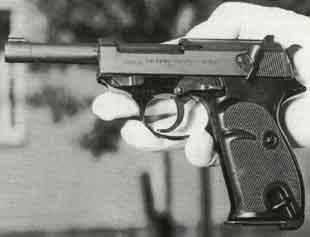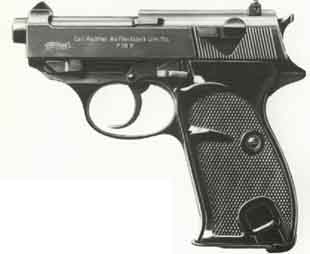Nation of origin: Federal Republic of Germany
Ammunition; 9 x 19 mm
Operation: locked breech
Weight: empty, 0.772 kg
Length: 218mm
Length of barrel: 124 mm
Magazine capacity: 8 rounds
Muzzle velocity: 350 m/s

Fig. -57: A Walther P1 in the neatly-gloved hand of a German military policeman.
The section devoted to the Walther PP and PPK should provide an indication 0 the importance of the Carl Walther Waffen fabrik concern on the European pistol scene. Their design experience was such that when the German armed forces began to expand and rearm, following Hitler’s coming to power, they were asked to submit a pistol design to replace the ageing Luger Pistole ‘08 (P’08) as the standard German service pistol.
Walther used all their experience to come up with a design, originally known as the ‘Armee Pistole’, or AP. This appeared in 1937 and was a new design with a locked breech operating system to accommodate the power of the 9 mm Parabellum cartridge that was carried over from the Luger P’08. The German authorities were impressed, but requested some changes, including the addition of an external hammer. That resulted in the ‘Heeres Pistole’ (service pistol, or HP). This the Army liked but again, some slight changes to make mass production easier were requested. The Pistole 38, or P38, then entered production during 1938.
The P38 remained in production until 1945 and proved itself to be a superlative service weapon. It was so good that once the new West German Bundeswehr was formed during the 1950s, the P38 was requested as their standard service pistol once again. Thus in 1957 the P38 was put back into production by Walther at their Ulm-am-Donau factory, but by then it was known as the Pistole 1, or P1.
The P1 is largely unchanged from the earlier P38. The main modification is the introduction of a light alloy (dural) slide in place of the earlier steel component, and some slight internal alterations have been made. The P1 can be readily identified by its protruding barrel and the chubby slide with a pronounced cutaway on the top. The double-action trigger mechanism enables the weapon to be cocked and fired by a single pull of the trigger (provided a round is in the chamber). The hammer strikes an internal firing pin and at the instant of firing the barrel is locked to the slide by a ramp. The recoil forces then cause the barrel and slide to move backwards locked together, until the barrel is prevented from moving further by a fixed stop; the slide continues to travel rearwards. By then, the internal chamber pressures will have fallen to a safe level and the rest of the ejection, feed and hammer cocking sequence can continue ready for the next shot.
Some of the safeties used in the earlier PP have been carried over to the P1. When the safety catch is applied, the firing pin is securely locked and cannot move, This means that the external hammer can be lowered safely when a round is in the chamber (this will happen automatically as the safety catch is actuated), although this should not be tried on old P38s, especially those
It is also an excellent pistol to handle and fire. It has smooth lines with few protuberances to snag on clothing or equipment, and once in the hand it demonstrates its excellent balance and aiming qualities. If the P1 does have a drawback, it is that the eight-round capacity of the box magazine is now much less than that of many other pistols in service elsewhere. The ammunition in the magazine remains as potent as it was when it was first devised during the early l as the 9 mm Parabellum is still a prodigious man-stopper.

Fig. -60: The Walther p 38 K, clearly showing its attenuated barrel.
The P1 is in service with the West German armed forces, and with many West German police forces. Export sales have been made to the armed forces of nations as disparate as Portugal, Norway, Chad and Chile, and to many police forces. To meet demands made by some police forces, a special version with a barrel shortened to only 70 mm was developed, and at one time was evocatively designated the P38K. A 7.65 x 21 mm Para bellum version was in production at one time, and there has even been a .22 version, for sales to target shooters. Numbers of P38s from the war years may still be encountered in police, arm- ed forces and freedom fighter armories all around the work but, as has been indicated above, the standard of finish and manufacture of some of these older weapons is nowhere near as good as those lavished on recent production examples. Service Pistols are usually recognizable by their overall matt black plating, while examples for the commercial market are often produced in a pronounced glossy blue finish; commercial models are known as the P4.
One small comment on the weapon that the P1/P38 was meant to replace: the Luger Pistole ‘08 is once more in production, this time by the Mauser-Werke at Obendorf, but the customers are no longer military. Modern production Lugers are sold to a wide spectrum of well-heeled pistol buffs and collectors.

Fig. -61: A war-time-production Walther P 38 with a standard of finish
far inferior to that of the modern P1. The P1 differs also in having
a light alloy slide in place of the steel slide used on the P 38.